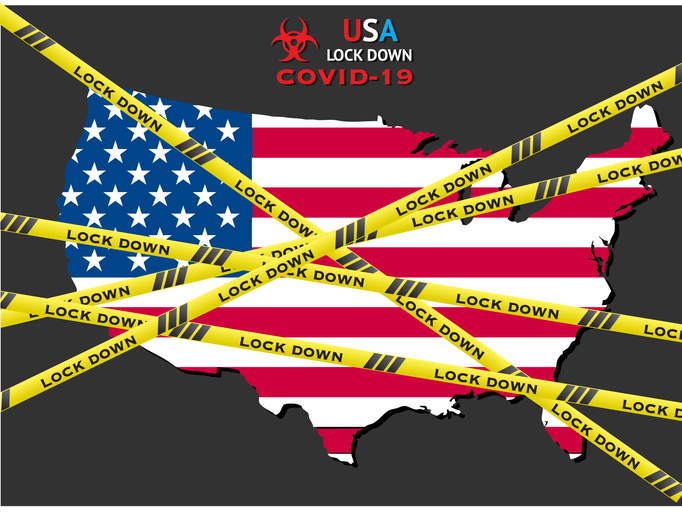Up to 100 million Americans could become infected with COVID-19 in the fall, the White House announced on May 6 and may require a different approach after new evidence that masks and lockdowns failed.
The U.S. public health establishment will have to change its approach to avoid repeating the costly mistakes made so far during the pandemic, according to Phil Kerpen (Committee to Unleash Prosperity), Casey Mulligan (University of Chicago), and Stephen Moore (Heritage Foundation), the authors of “A Final Report Card on the States’ Response to COVID-19,” published by the National Bureau of Economic Research (NBER).
“The COVID-19 pandemic was distinct from other previous health pandemics in the degree to which we saw government interventions in the economy and suspension of individual freedoms —including policies such as lockdowns, curfews, mask and vaccine mandates, mandatory business closures, school shutdowns, and so on,” state the authors.
It is doubtful proponents of lockdowns have learned from their mistakes, said Phil Kerpen, one of the study’s authors, on the Heartland Daily Podcast.
“I fear that a lot of the liberal politicians and so-called public health experts would rather make the same mistakes over again than admit they were wrong,” said Kerpen.
Lockdowns Not Protective
The NBER study compared the 50 states and the District of Columbia on three metrics: death rates from COVID, adjusted for comorbidities; unemployment and output growth; and the number of days schools were open (see table below).
The authors adjusted COVID-19 mortality through March 5, 2022, for age and the pre-pandemic prevalence of obesity and diabetes, which are highly correlated with higher COVID death rates.
They found mortality and economic performance were unrelated, indicating economic lockdowns did not impact health. But they did find a positive correlation between state economic performance and the number of days schools were open.
Montana scored highest on economy, followed in order of performance by South Dakota, Nebraska, and Utah. These three states were also among the seven states that kept 85 percent of their schools open.
States Graded
The authors graded the states on their combined scores.
Receiving A-pluses, in order of their scores, were Utah, Nebraska, and Vermont. Earning an A were Montana, South Dakota, Florida, Maine, New Hampshire, and Arkansas.
Receiving Fs, in order from highest to lowest, were Illinois, California, New Mexico, New York, and the District of Columbia, with New Jersey finishing last.
The study singles out Florida, which kept businesses running. “Although sometimes criticized as having policies that were ‘too open,’ Florida proved to have average mortality while maintaining a high level of economic activity and 96 percent open schools,” states the report.
Masks Missed Mark
School mask mandates didn’t slow the spread of the virus while significantly disrupting children’s education, state Emily Burns, Josh Stevenson, and Phil Kerpen in a study titled “No, Masks Don’t Help Keep Kids in School,” published on substack.com.
“One of the reasons we were told masks were essential for school kids this year was that masks would reduce the likelihood of school closures, by reducing disease incidence,” the report noted. “Unfortunately, like so much the CDC [Centers for Disease Control and Prevention] has promised, the opposite turns out to be true … Children in masked districts experienced, on average, four times the number of disrupted learning days as those in mask-optional districts. The same districts had 2.5 times higher case rates during the same period [the January peak of the Omnicron wave].”
It is unclear why masked districts were more likely to stay closed, Kerpen told the Heartland Daily Podcast.
“The masks create panic and an edge and when you get people already on edge and you get into the winter and you have a seasonal uptick in cases, [they close the schools],” said Kerpen. “In the places where things were more normal, you get a seasonal increase and they say, well we sort of expected that [and] we’re not going to get into a panic. You didn’t get zero closures in mask optional places, but fewer, because they were driven by real absenteeism instead of perception and theory.”
Bonner R. Cohen, Ph.D. (bcohen@nationalcenter.org) is a senior fellow at the National Center for Public Policy Research.
Internet info:
“Masks Caused Schools to Close More Often, Not Less (Guest: Phil Kerpen), The Heartland Daily Podcast, April 25, 2022: https://www.heartland.org/multimedia/podcasts/masks-caused-schools-to-close-more-often-not-less-guests-phil-kerpen
For more great content from Health Care News.
State Pandemic Performance – Combined Score
A+
Utah 3.46
Nebraska 3.25
Vermont 3.24
A
Montana 2.29
South Dakota 2.08
Florida 2.04
New Hampshire 1.99
Maine 1.95
Arkansas 1.88
B
Idaho 1.63
Iowa 1.43
South Carolina 1.32
North Carolina 1.15
North Dakota 1.08
West Virginia 1.01
Missouri .70
Kansas .70
Indiana .66
C
Georgia .57
Alabama .43
Wyoming .42
Washington.36
Mississippi .24
Tennessee .18
Texas .06
Minnesota -.16
Rhode Island -.16
Kentucky -.19
Louisiana -.29
Oregon -.37
D
Wisconsin -.61
Ohio -.62
Alaska -.63
Oklahoma -.63
Colorado -.68
Virginia -.78
Arizona -.91
Delaware -.95
Hawaii -1.01
Michigan -1.27
Massachusetts -1.44
Pennsylvania -1.45
Connecticut -1.51
Nevada -1.57
Maryland -1.64
F
Illinois -2.28
California -2.51
New Mexico -2.61
F-
New York -2.94
District of Columbia -3.30
New Jersey -3.61
Source: Committee to Unleash Prosperity




















